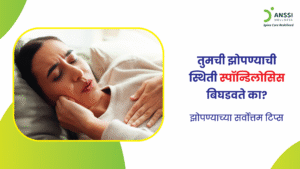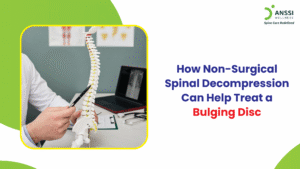Driving offers freedom and convenience, but if you are someone who spends long hours behind the wheel, it can come at a painful cost. Neck pain is one of the most common complaints among regular drivers, especially those who spend hours commuting, traveling for work, or operating vehicles professionally.
Poor posture, seat misalignment, and constant road vibrations can gradually strain the cervical spine, leading to stiffness, discomfort, or even chronic pain. The good news? With the right adjustments and habits, you can enjoy every drive without compromising your neck health.
How Driving Affects the Cervical Spine
When you sit in a car seat for long periods, your spine is exposed to several stressors.
- Prolonged sitting naturally reduces blood flow to the muscles, making them tense and less flexible.
- Road vibrations and jerks further aggravate the spine, especially the neck and upper back.
- Over time, these repetitive micro-stresses can cause fatigue and inflammation in the cervical muscles and joints.
Another key factor is poor posture while driving.
- Many drivers unknowingly lean forward, tilt their heads, or slouch, especially during long drives or in heavy traffic.
- This posture, often called forward head posture, increases the weight load on the cervical spine, forcing the neck muscles to overwork.
- The result? Tightness, pain, and stiffness that may extend to the shoulders and upper back.
Additionally, constantly turning your head to check mirrors or blind spots adds rotational strain to the neck. Without proper alignment and support, these repetitive movements can eventually lead to chronic cervical issues or even disc-related problems like cervical spondylosis.
Preventive Measures for a Pain-Free Driving Experience
Thankfully, neck pain caused by driving isn’t inevitable. Simple ergonomic and posture adjustments can drastically reduce strain and help protect your spine.
1. Adjust Your Seat for Comfort and Alignment
Your seat should support your spine’s natural curve.
- Make sure your hips are just a little bit higher than your knees by adjusting the seat height.
- The backrest should be at a reclined angle of about 100-110 degrees, allowing your back to rest fully against it.
- Avoid leaning too far forward or sitting too upright, as this can increase neck tension.
2. Maintain Proper Headrest Position
Your headrest plays a vital role in protecting your neck, especially in case of sudden stops or jerks.
Position the headrest so that the middle of it aligns with the back of your head, not your neck. This placement keeps your head and spine aligned, minimising the risk of strain and whiplash-type injuries.
3. Keep Your Steering Wheel Within Easy Reach
The steering wheel should be positioned close enough that your elbows remain slightly bent. Stretching your arms too far forward causes your shoulders and neck to tense up, leading to fatigue over time.
4. Use Supportive Accessories
- Consider using lumbar cushions or seat wedges to support your lower back.
- For longer drives, a neck pillow or cervical roll can help maintain natural alignment and reduce muscle strain.
Ensure these accessories are firm enough to provide support but comfortable enough for extended use.
5. Take Regular Breaks and Stretch
Even the best driving posture can’t replace movement.
- Take short breaks every hour during long drives. Get out, walk around, and gently stretch your neck and shoulders.
- Simple movements like neck tilts, shoulder rolls, and chin tucks help relieve stiffness and improve blood flow.
6. Be Mindful of Your Posture
Good posture not only reduces pain but also improves focus and alertness.
- Constantly remind yourself to sit tall.
- Keep your shoulders relaxed, head in line with your spine, and chin slightly tucked in.
- Avoid craning your neck forward to look at the road or phone navigation.
Non-Surgical Solutions for Chronic Neck Pain
Despite your best efforts, chronic neck pain can sometimes persist, especially if underlying spinal issues like disc compression or cervical misalignment exist. Fortunately, several non-surgical treatments can help you restore spinal balance and relieve discomfort effectively.
Physiotherapy
Physiotherapy helps strengthen neck and shoulder muscles, improve flexibility, and correct posture imbalances. A trained physiotherapist may recommend gentle stretching, strengthening exercises, or manual therapy techniques to reduce muscle tension and improve mobility.
Ice and Heat Therapy
Simple home remedies can make a big difference.
- Applying ice helps reduce inflammation and numb soreness after long drives.
- Heat therapy, on the other hand, increases blood circulation, relaxing tight muscles and easing stiffness.
Alternating between the two often provides the best relief.
Non-Surgical Spinal Decompression Treatment
For persistent or chronic neck pain, non-surgical spinal decompression treatment offers a scientifically proven, non-invasive solution.
This advanced treatment gently stretches the spine, creating negative pressure within the cervical discs. This relieves nerve compression, enhances blood flow, and allows discs to rehydrate naturally. Spinal decompression is completely drug-free, injection-free, and surgery-free, making it ideal for those seeking long-term relief without risk or downtime.
Lifestyle and Posture Correction
Combining treatment with healthy habits ensures sustainable improvement. Staying hydrated, maintaining good posture while working or sleeping, and engaging in low-impact exercises like swimming or yoga can prevent the recurrence of neck pain.
About ANSSI:
ANSSI Wellness focuses on improving the quality of life for patients suffering from spinal issues, aiming to provide relief where other conventional treatments have failed. Through advanced Non-Surgical Spinal Decompression Treatment, ANSSI is committed to helping patients avoid surgery and recover in a safe, effective, and compassionate environment.
Connect with ANSSI Wellness on LinkedIn, Instagram, and Facebook for expert guidance.




